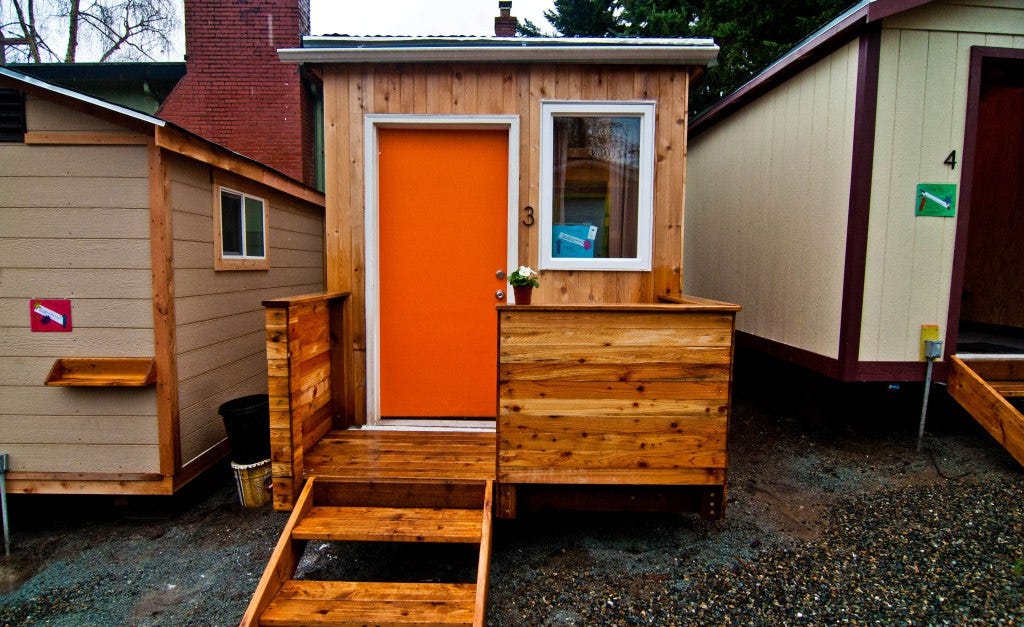SEATTLE ORGANIZATION CREATES TINY HOME VILLAGE FOR THE HOMELESS

An organization in Seattle, Washington will open up a tiny house village on Wednesday to provide 40 homes to families living on the streets.
Built by the homelessness advocacy group Low Income Housing Institute (LIHI) on a piece of land that the agency owns, the 40 tiny houses will provide much-needed temporary shelter to serve about 70 people who are among the city’s swelling homeless population. The houses, which are 12-foot by eight-foot, will be staffed by two full-time workers who will ensure the security of the village. There will also be a communal kitchen and a place to shower.
The tiny homes, built by high school and college students through a vocational training program, have doors that lock, windows, heat, insulation, and electricity, according to King 5, a Western Washington NBC affiliate.
“Instead of people being swept [from homeless camps] and then being homeless, they’re going to be offered an opportunity to come here,” LIHI executive director Sharon Lee told the publication MyNorthwest. “This is a low barrier philosophy, in terms of: you can come as you are. So if you have a drinking problem, it’s not required that you be sober in order to live here. But you have to be on your good behavior. You have to be cooperative and you can’t do harm to anybody.”
“So everybody will have to check-in, sign-in. There will be chores,” Lee added. “People will be assigned, like, kitchen duty, clean-up duty, maybe doing litter pickup in the community. We expect everyone to participate just like any household.”
Through the tiny homes initiative, LIHI has already provided homes for 161 people, with 106 people who became gainfully employed while working with case managers, and 34 were reunited with family or friends, LIHI housing advocate John Castle told King 5. At least two such tiny home villages have been open since 2015.
“It’s a big step up from tent cities, one piece of the puzzle in solving this huge problem, so I think it’s a good thing,” Castle said.
After Seattle Mayor Ed Murray declared a state of emergency on homelessness in late 2015, city officials proposed spreading 1,000 tiny homes throughout the city, in return for stronger enforcement of a no-camping law.
The promise of shelter could be a matter of life and death for Seattle’s nearly 3,000 homeless population. The King County medical examiner said that at least 69 people died in 2016 from living on the streets, in part because of exposure, poor health, violence, gunshot wounds, drugs, suicides, and being run over by cars, Crosscut reported.
These tiny homes were quickly built because they are under 120 square feet and therefore not considered dwelling units under the International Building Code, according to Crosscut.
Advocates like Steve Berg, vice president for programs and policy at the advocacy group National Alliance to End Homelessness, believes that cities would do more to alleviate homelessness by providing affordable housing in addition to providing stopgap measures like temporary tiny homes.
“Keeping people safe temporarily is a good thing, but not the whole thing,” Berg told ThinkProgress.
Berg said that city officials should prioritize housing resources particularly on people are living on the streets, but long-term policies should address “insufficient affordable housing” to make sure that the market is encouraged to invest public dollars into creating more housing that people can afford.
“Even in a place like Seattle, most low-income people are not homeless — they’ve managing to stay housed — part of the solution is to make sure homeless people are housed the same way,” Berg added. “But there is absolutely a whole other part of the solution which is to fix the larger affordable housing problem.”
Federal policies have never followed through on the promise of the 1949 Housing Act to put together programs that compel the financial resources needed to implement affordable housing for “every American.” In Seattle where rents have increased 43 percent in the last four years, almost 10,000 market-rate apartments were set to open by 2016. But not enough is being done to increase the inventory of affordable housing.
Seattle’s Downtown Emergency Service Center manages roughly 1,000 units of “supportive housing,” or housing with supportive services on site, is already strained. Most recently in January, nearly 2,100 people entered a lottery to live in a 108-unit rental building for low-income families for families making between 30 and 60 percent of the area’s median income, or $18,990 and $67,200 annually.








Follow Us!